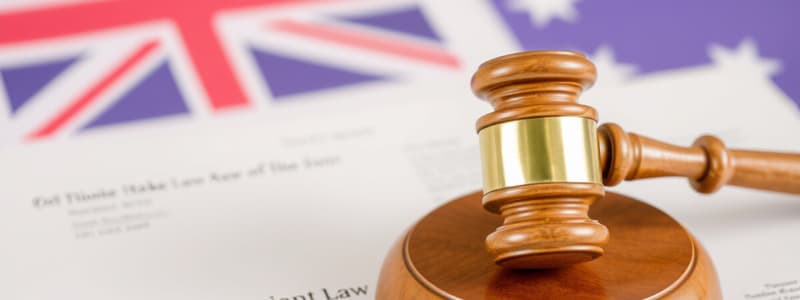Podcast
Questions and Answers
What year was the Family Court of Australia established?
What year was the Family Court of Australia established?
- 1901
- 2001
- 1975 (correct)
- 1980
The High Court of Australia has only original jurisdiction.
The High Court of Australia has only original jurisdiction.
False (B)
What is the primary function of the Family Court of Australia?
What is the primary function of the Family Court of Australia?
To rule on cases related to family law matters such as divorce and parenting orders.
Statute law is also known as __________.
Statute law is also known as __________.
Match the following functions to their respective courts:
Match the following functions to their respective courts:
What must happen for a Bill to become an Act of Parliament?
What must happen for a Bill to become an Act of Parliament?
The Parliament in New South Wales is unicameral.
The Parliament in New South Wales is unicameral.
What is a Bill?
What is a Bill?
What is the primary difference between common law and statute law?
What is the primary difference between common law and statute law?
Equity was developed to complement common law and provide more flexible remedies.
Equity was developed to complement common law and provide more flexible remedies.
What body of law applies when statute law does not exist?
What body of law applies when statute law does not exist?
The legal system in Australia is primarily based on ___________ law and ___________ law.
The legal system in Australia is primarily based on ___________ law and ___________ law.
Match the terms with their definitions:
Match the terms with their definitions:
Which of the following correctly describes the development of common law?
Which of the following correctly describes the development of common law?
Statute law takes precedence over common law when both exist.
Statute law takes precedence over common law when both exist.
William the Conqueror sent __________ around England to ensure disputes were settled uniformly.
William the Conqueror sent __________ around England to ensure disputes were settled uniformly.
What does a referendum refer to?
What does a referendum refer to?
Exclusive powers can be exercised by both state and federal parliaments.
Exclusive powers can be exercised by both state and federal parliaments.
What are concurrent powers?
What are concurrent powers?
Section 51 of the constitution specifies the legislative powers of the __________.
Section 51 of the constitution specifies the legislative powers of the __________.
Match the following types of powers with their definitions:
Match the following types of powers with their definitions:
Which of the following is an example of residual power?
Which of the following is an example of residual power?
In the case of Commonwealth v Tasmania, the Tasmanian Government's decision was upheld.
In the case of Commonwealth v Tasmania, the Tasmanian Government's decision was upheld.
What does Section 109 state about laws of the state and commonwealth?
What does Section 109 state about laws of the state and commonwealth?
What was the outcome of the High Court's ruling regarding the dam construction?
What was the outcome of the High Court's ruling regarding the dam construction?
The World Heritage Act 1983 (Cth) was passed by the state government.
The World Heritage Act 1983 (Cth) was passed by the state government.
What section of the Constitution allows the federal law to override state law?
What section of the Constitution allows the federal law to override state law?
The High Court primarily deals with cases concerning the interpretation of the _______ Constitution.
The High Court primarily deals with cases concerning the interpretation of the _______ Constitution.
Match the following components of the government with their roles:
Match the following components of the government with their roles:
Which body is responsible for administering the laws made by the Parliament in Australia?
Which body is responsible for administering the laws made by the Parliament in Australia?
The separation of powers helps prevent the abuse of power in government.
The separation of powers helps prevent the abuse of power in government.
What is considered one of the cornerstones of democracy regarding government structure?
What is considered one of the cornerstones of democracy regarding government structure?
What role do Aboriginal people have concerning their land?
What role do Aboriginal people have concerning their land?
Kinship refers only to immediate family relationships in Aboriginal cultures.
Kinship refers only to immediate family relationships in Aboriginal cultures.
What is a sanction in the context of Aboriginal law?
What is a sanction in the context of Aboriginal law?
Elders often intervene in decisions related to enforcing the law and applying _____ when sacred law is broken.
Elders often intervene in decisions related to enforcing the law and applying _____ when sacred law is broken.
How are customary laws traditionally passed down?
How are customary laws traditionally passed down?
Match the following terms with their definitions:
Match the following terms with their definitions:
Formal judicial processes are typically used in resolving disputes under customary law.
Formal judicial processes are typically used in resolving disputes under customary law.
What is one example of a punishment that might be imposed under customary law?
What is one example of a punishment that might be imposed under customary law?
Flashcards are hidden until you start studying
Study Notes
Sources of Contemporary Australian Law
- Australian law originates from common law, statute law, and constitutional law.
- Common law consists of court-created laws based on judicial decisions and precedents.
- Statute law is enacted by parliament and represents formal legislation.
- Constitutional law outlines the framework for governance and legal authority in Australia.
Common Law
- Developed in England, common law is the legal system adopted by Australia upon British colonization in 1788.
- Judges rely on common law principles only when relevant statute law is absent.
- In cases of conflict, statute law prevails over common law.
- Common law evolved from judicial decisions influenced by tradition, customs, and precedents.
Equity
- Equity provides remedies that complement common law, focusing on fairness and justice.
- Developed because strict common law procedures often led to unjust outcomes.
- Equitable remedies are especially necessary in complex cases where monetary compensation is insufficient.
Family Court of Australia
- Established in 1975 to handle intricate family law issues, including divorce, parenting orders, and property division.
- Can hear appeals from federal magistrates and individual Family Court judges.
High Court of Australia
- Formed in 1901 under section 71 of the Australian Constitution, it's the Supreme Court of the judicial system.
- It addresses appeals from lower courts and interprets the Constitution.
Statute Law
- Statute law is created by parliament and is also known as legislation or Acts of Parliament.
- The Australian Constitution delineates the law-making powers of state and federal parliaments.
Role and Structure of Parliament
- Parliament comprises elected representatives responsible for debating, amending, and passing legislation.
- The New South Wales parliament is bicameral, consisting of the Governor, Senate, and House of Representatives.
Legislative Process
- A new law proposed in parliament is called a Bill.
- Passing a Bill involves multiple readings and requires approval from both Houses and the Governor-General to become an Act of Parliament.
Division of Powers
- Sections 51-60 of the Constitution specify legislative powers between Commonwealth and State parliaments.
Legislative Power
- Legislative power refers to the authority to create laws, shared by the Commonwealth and states under Section 51.
Concurrent Power
- Concurrent powers are shared by both Commonwealth and state parliaments over areas like education, health, and taxation.
Exclusive Power
- Only the Commonwealth can exercise exclusive powers as defined by Section 52, covering areas such as external affairs and national defense.
Residual Power
- Residual powers are reserved for states, covering matters not specified in the Constitution.
Commonwealth v Tasmania (1983)
- The case involved a conflict over a hydroelectric dam proposal and the protection of a World Heritage site.
- The High Court ruled that federal law (protecting heritage sites) supersedes conflicting state law, referencing Section 109 of the Constitution.
Separation of Powers
- Comprises the legislature (parliament), executive (government), and judiciary (courts), ensuring checks and balances in government.
- Protecting the judiciary's independence is essential for democracy and the rule of law.
Role of the High Court
- Essential for interpreting constitutional matters and ensuring the validity of laws.
Indigenous Law and Custodianship
- Aboriginal peoples are viewed as custodians of the land, signifying a deep connection with their history and culture.
- Customary laws, passed down orally, govern relationships, rituals, and community responsibilities.
Mediation and Sanctions
- Elders serve as mediators in disputes and apply sanctions for breaches of customary laws.
- Sanctions vary from fines to severe forms of punishment, like exile or death.
Relevance to Contemporary Australian Law
- Elements of customary law are integrated into modern Australian law, influencing environmental policies and dispute resolution.
- Aboriginal traditions may be considered during legal proceedings to mitigate sentences based on cultural practices.
Studying That Suits You
Use AI to generate personalized quizzes and flashcards to suit your learning preferences.




